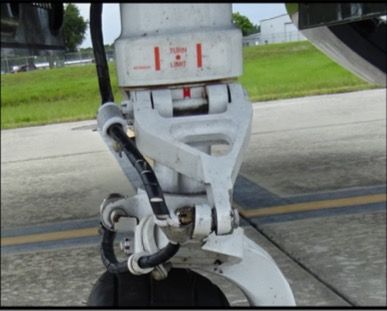An NTSB final report (search ERA20LA237 here ) appears to shed at least some light on the cause of a series of puzzling runway excursions by high-performance Piper singles in the last couple of years. It appears improper ground handling led to the excursion by a PA46 at Titusville Airport in Florida on July 3, 2020. The nosegear turned 90 degrees from the centerline on touchdown and the pilot was unable to keep it from skidding off the runway. It was substantially damaged but he wasn’t hurt. The NTSB determined “the airplane was towed beyond the left turn limits at some point before the accident flight, which fractured one or two of the steering horn attachment bolts.” The NTSB is investigating at least five other PA46 excursions with similar circumstances but this report doesn’t mention any correlation.
The operator of the aircraft told investigators he was aware of the towing limits on his airplane and he had never seen it improperly towed, but he also said he didn’t know how many times it may have been towed without his knowledge. The nosegear is attached to the steering horn with a vertical shaft and three bolts on a flange. There are lines painted on the gear showing the safe turn limits when using a tow bar, which can act as a lever to deliver enough torque to shear the attachment bolts if the turn is too sharp. The NTSB deduced at least one of those bolts had to be attached after takeoff on the accident flight because the gear won’t stow unless the wheel is turned 90 degrees during retraction and one or more failed on landing.




































Similar problems can occur in Beech Bonanzaa and Barons. The scissors that hold the nosewheel straight are of dissimilar metals, so that improper towing will break one of the arms rather than the main structure. Damage here is usually a crack where the scissors join, often obscured by grease from the fitting mounted there. My nosegear failed at that point on takeoff in my B55 Baron, the nosewheel turning sideways. That led to the nosegear collapse and a fairly high speed exit off the side of the runway with both engines at full power. A large snowbank (from runway plowing) brought us to a halt after ripping out the left main gear completely. 8 months later and about 60K got us back in the air, and thereafter, VERY meticulous inspections of the nosegear on preflight. Post accident inspection showed that the crack had developed internallly from the grease fitting and would not have been noticeable until just before complete failure.
> the crack had developed internallly from the grease fitting
Same with Caterpillar heavy equipment.
I had the same issue occur with the Club PA-28-181 Archer. Upon landing, when the nose wheel touched down, a tremendous vibration occurred. I had no problem controlling the aircraft, and brought it to a complete stop on the runway. I advised tower of issue, and advised that I would exit the aircraft to look over the aircraft. I found the nose wheel was turned 90 degrees. I re- entered the aircraft and advised them of what I had found. They said they would send a tug out to get me so the runway could be reopened. I was adjacent to a taxiway, so I asked if I could use the tow bar to pull the aircraft off the active and onto the taxiway, so the runway could be re-opened. They told me yes and I met the tug on the taxiway. On raising the cowling, it revealed that the steering horn had broken. When we had it replaced, an old mechanic told me that the problem was caused by moving the rudder pedals from right to left while the aircraft was not moving, during pre-flight. He said that if it worked to get you to the run-up area, everything was good! On takeoff, if no rudder response, you would have no problem aborting the takeoff. This information was relayed to the club members, but one guy disagreed and continued doing it. A couple of months later, the same issue occurred.
So doing control travel check before flight can damage the airplane?
Bad design?
Some of the PA-28s link the rudder to the nose wheel with a bungee cord (like most single-engine Cessnas that I know of), while others (most, I believe) are directly attached to the nose wheel. This means that whenever one of them moves (pedals, nose gear, rudder), all of them move together.
It’s not necessarily a control travel check that is the problem, but rather how you perform the check. Every aircraft has some systems peculiarity that you just have to learn.
Thanks.
But how do you do a check for full travel of controls?
A call to the destination FBO indicating I do not want to be towed once parked, so, park me where I will not be towed coupled with a “DO NOT TOW” sign on both sides of my windshield works wonders.
As PA46 pilots/owners, we deal regularly with group or corporate hangars – primarily due to 43′ wingspan which eliminates most/typical hangars. Towing or repositioning of our planes is part of the deal. I’ve studied this issue since it was drilled into me during my transition course and spend a lot of time during preflight on touching the components of the nose gear.
> owing or repositioning of our planes is part of the deal.
Good to know. Another reason to shop for planes that fit in a small hangar!